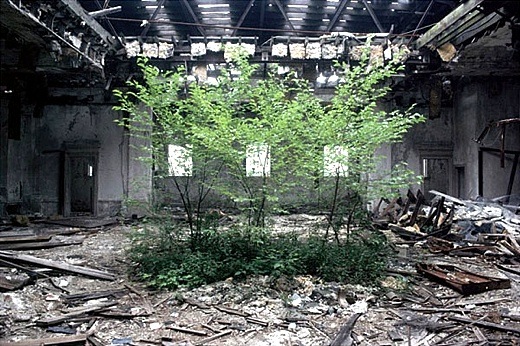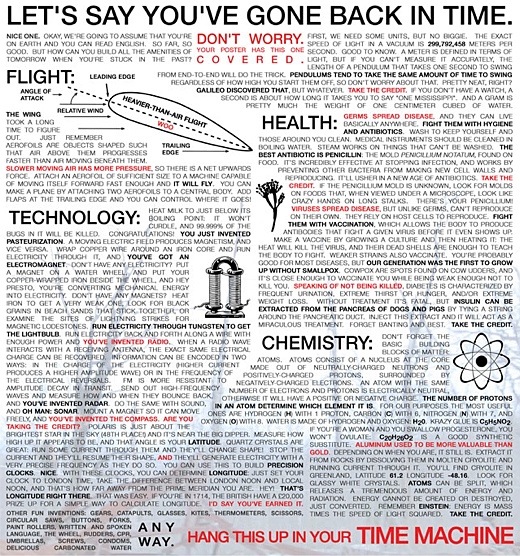 By Amanda Reed on 7 April 2010 in WorldChanging -
(http://www.worldchanging.com/archives/011064.html)
By Amanda Reed on 7 April 2010 in WorldChanging -
(http://www.worldchanging.com/archives/011064.html)
One of the ways people respond to stories about climate change, peak oil, the idea of a coming Apocalypse, or even the current recession, is to conclude that civilization as we know it is going to collapse in the near future. Some people plan ways of surviving 'the fire', others look to rebuilding or restarting a new civilization from the ashes. The first response is usually characterized by isolated and individual survival plans where people retreat from society and survive in bunkers; whereas the latter response is a bit more community focused and stems from a desire to reset, restart and rebuild human civilization.
In his recent blog post titled "Manual for Civilization" Alexander Rose examines the creation of "Doomsday Manuals," projects of various forms that provide a way of creating a record of humanity and technology that would help restart civilization. While the intent behind the creation of Doomsday Manuals is positive, he also raises some excellent concerns about their eventual efficacy:
...proposals have been in different forms; create a book, set of books, stone tablets, micro-etched metal disk, or a constantly updated wiki...These Doomsday Manuals are a positive step in the direction of making a softer landing for a collapse, and the people creating them (like ourselves) are certainly out to help people...However it also seems that these efforts tap a romantic notion that we would all love to find something like this book from a past or otherwise alien civilization. My worry is that it also feeds off a (likely incorrect) feeling that somehow collapse might be a fun challenge to live through, and that everyone kind of wants to be the monk in "A Canticle For Leibowitz" or Mel Gibson in "Road Warrior". My bet is that the reality of watching your civilization (and population) collapse is likely one of the worst things anyone could experience. I am also not so sure the problem is just knowing how to remake a technology.
Despite these concerns Rose created an interesting list of current projects that attempt to serve as manuals of civilization. Here is a selection of projects from his list (to see the full list click here):
Westinghouse Time Capsules:
Two time capsules (they actually coined the term for this project) by Westinghouse buried at Worlds Fair sites, one in 1939 and the other in 1965 to be recovered in 5000 years. They also did the very smart thing of making a “Book of Record” and an above ground duplicate of the contents on display.
 Image above: Replica of the 1938 Westinghouse Time Capsule courtesy of Wikipedia author Doug Coldwell under the Creative Commons License.
The Voyager Record:
The Voyager Golden Record are phonograph records which were included aboard both Voyager spacecraft, which were launched in 1977. They contain sounds and images selected to portray the diversity of life and culture on Earth, and are intended for any intelligent extraterrestrial life form, or far future humans, who may find them. The audio includes a cut by Chuck Berry.
Image above: Replica of the 1938 Westinghouse Time Capsule courtesy of Wikipedia author Doug Coldwell under the Creative Commons License.
The Voyager Record:
The Voyager Golden Record are phonograph records which were included aboard both Voyager spacecraft, which were launched in 1977. They contain sounds and images selected to portray the diversity of life and culture on Earth, and are intended for any intelligent extraterrestrial life form, or far future humans, who may find them. The audio includes a cut by Chuck Berry.
 Image above: Voyager carried Golden Record created by NASA . The naked humans that were etched on the earlier 1972 Pioneer plate, suggested by CArl Sagan, were removed.
Image above: Voyager carried Golden Record created by NASA . The naked humans that were etched on the earlier 1972 Pioneer plate, suggested by CArl Sagan, were removed.
Georgia Guidestones:
The four granite Guidestones are covered in inscriptions written in 8 major languages that describe the tenets of an imagined Age of Reason.
 Image above: Georgia Guidestones courtesy of Flickr photographer Ampersand100 under the Creative Commons License.
Once a medium is chosen for a Doomsday Book, or manual for civilization, there is still a question of what to include in the record. Rose provides a list of links to content that has been discussed for inclusion, from the Penn State College of Agricultural Science 2-page PDF pocket guide on how to dress a dear, to lighter fare like this:
Image above: Georgia Guidestones courtesy of Flickr photographer Ampersand100 under the Creative Commons License.
Once a medium is chosen for a Doomsday Book, or manual for civilization, there is still a question of what to include in the record. Rose provides a list of links to content that has been discussed for inclusion, from the Penn State College of Agricultural Science 2-page PDF pocket guide on how to dress a dear, to lighter fare like this:
Lets Say You've Gone Back in Time Poster Poster created for time traveller. Go back in time with this as a guide and you'll invent heavier-than-air flight! YOU'LL discover penicillin. You'll be the first to isolate aluminum. Did you know aluminum used to be more valuable than gold?
 Image above: From (http://www.topatoco.com/merchant.mvc?Screen=PROD&Store_Code=TO&Product_Code=QW-CHEATSHEET-PRINT&Category_Code=QW-PRINTS)
At the beginning of this post I posited that manuals for civilization stem from a desire to reset, restart and rebuild human civilization in the model it exists now (prior to collapse) -- where "civilization" and "now" are heavily "biased toward the English language, the United States and Western culture," as Rose notes. But is that really wise? If the civilization 'we' have now is what will lead us to collapse, then why should we try to replicate that model in the future? Furthermore, why should we wait until civilization collapses to reset, restart and rebuild human civilization? I think the vision of a bright green future offers an alternative view to imminent collapse: If we work hard now, then we can avoid collapse. And, if you're a romantic like me, you can look forward to contributing to a future manual for civilization filled with bright green ideas.
See The Long Now Blog for Rose's full list of "manuals for civilization" projects as well as a list of content that may be included in those manuals. These lists are actively being updated per reader feedback, so be sure to check it out as it grows if this is of interest to you.
Image above: From (http://www.topatoco.com/merchant.mvc?Screen=PROD&Store_Code=TO&Product_Code=QW-CHEATSHEET-PRINT&Category_Code=QW-PRINTS)
At the beginning of this post I posited that manuals for civilization stem from a desire to reset, restart and rebuild human civilization in the model it exists now (prior to collapse) -- where "civilization" and "now" are heavily "biased toward the English language, the United States and Western culture," as Rose notes. But is that really wise? If the civilization 'we' have now is what will lead us to collapse, then why should we try to replicate that model in the future? Furthermore, why should we wait until civilization collapses to reset, restart and rebuild human civilization? I think the vision of a bright green future offers an alternative view to imminent collapse: If we work hard now, then we can avoid collapse. And, if you're a romantic like me, you can look forward to contributing to a future manual for civilization filled with bright green ideas.
See The Long Now Blog for Rose's full list of "manuals for civilization" projects as well as a list of content that may be included in those manuals. These lists are actively being updated per reader feedback, so be sure to check it out as it grows if this is of interest to you.
No comments :
Post a Comment